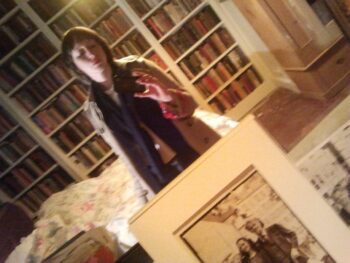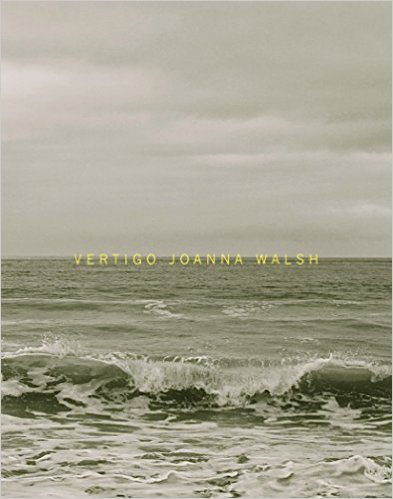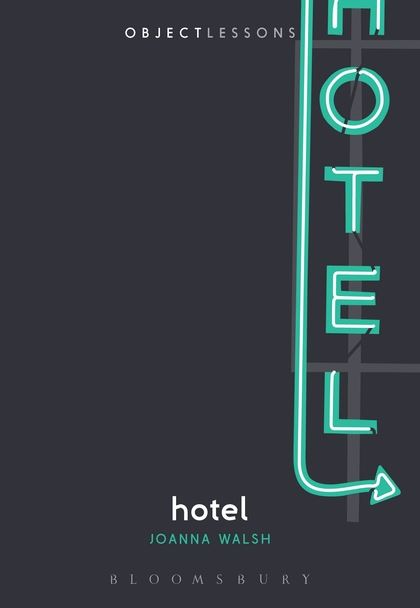
I first learned of Joanna Walsh through her #ReadWomen2014 project, which helped bring much needed attention to not only how we read but to how women are published—or not—and to women writers we may not have read before. Of the project, Walsh wrote in the Guardian:
It has been exciting to see some of the ways the hashtag has been used: as a personal incentive; a rallying cry; a celebration of recent achievements (2013 prizes for Alice Munro, Lydia Davis, Eleanor Catton, and more) and of authors who should be better known.
Later I read Vertigo, Walsh’s own cinematic and gently disorienting collection of stories, which has just been put out by Dorothy, a publishing project. Maybe it’s fitting that when I finally met Walsh in person, last month in London, we walked through an exhibit at a museum—Barbara Hepworth at the Tate Britain—talking only occasionally while looking at Hepworth’s sculptures. Walsh has also recently published Hotel (Bloomsbury) and Grow a Pair (Readux Books). In the conversation that follows, I asked Walsh a few questions about the stories in Vertigo.
***
The Rumpus: When I read Vertigo this past summer, I felt a kinship towards it, with its quiet precision and sense of floating, its ways of being “unattached” at times, if that makes sense, to its subject matter. There is a kind of sarcasm to the narrative voice as well, and all of these things add up to a quality we don’t often see/read in fiction. I like what happens when they join up, this wry commentary that is almost within a space of meditation, or if not meditation, that is awake to something beyond itself. Where do your stories begin? How do you first make contact with them?
 Joanna Walsh: I like the idea that my stories are external to me, and that I “make contact” with them. This image suits my process more than the “building” metaphors I often hear, or Sontag’s thing about writing being like trying to shove a large piece of furniture through a doorway. I can’t think of my work as something big and concrete; it’s always tenuous, a delicate drawing-together of things that already exist, a lot of “noticing.” So I lie in wait for stories to arrive, a bit like a butterfly collector; if I’m lucky, I might even see them breed. I keep notebooks, and, when something seems to be forming—i.e. if I keep writing things that seem to fit together—I think about what could be made of it. I agree that my narrators have a relationship to language and narrative in which they are at least partially aware of its artifice, and sometimes its limits. I like Christine Brooke-Rose’s novel Amalgamemnon, written as the tricksy stream-of-consciousness of its heroine, Mira Enketei. The author called this “utterly other discourse… the woman reading and thinking quite other things until she has to switch back to talking to the man.” I’m sure this applies to men too in certain situations, but I think that there are many scenarios in which women still have a gendered relationship to language: to what they’re allowed to voice, to what they might be thinking.
Joanna Walsh: I like the idea that my stories are external to me, and that I “make contact” with them. This image suits my process more than the “building” metaphors I often hear, or Sontag’s thing about writing being like trying to shove a large piece of furniture through a doorway. I can’t think of my work as something big and concrete; it’s always tenuous, a delicate drawing-together of things that already exist, a lot of “noticing.” So I lie in wait for stories to arrive, a bit like a butterfly collector; if I’m lucky, I might even see them breed. I keep notebooks, and, when something seems to be forming—i.e. if I keep writing things that seem to fit together—I think about what could be made of it. I agree that my narrators have a relationship to language and narrative in which they are at least partially aware of its artifice, and sometimes its limits. I like Christine Brooke-Rose’s novel Amalgamemnon, written as the tricksy stream-of-consciousness of its heroine, Mira Enketei. The author called this “utterly other discourse… the woman reading and thinking quite other things until she has to switch back to talking to the man.” I’m sure this applies to men too in certain situations, but I think that there are many scenarios in which women still have a gendered relationship to language: to what they’re allowed to voice, to what they might be thinking.
Rumpus: I lose sight sometimes of how differently writers see their process/es of writing, how different the ways to describe it. I like what you say here: “a delicate drawing-together of things that already exist.” And I love this, “the woman reading and thinking quite other things until she has to switch back to talking to the man,” that interior life, and the ways in which we often live within it much more truly than we do the exterior, the simultaneity this suggests simply in living, thinking, reading, one discourse running through our minds even as we speak another. It also makes sense to me in thinking about the stories in Vertigo.
Walsh: One thing I’m always trying to do is find ways of expressing the simultaneity of direct—especially sensual—experience, memory, and acquired knowledge that go to make up consciousness, and to evoke these simultaneously. I almost think of it as polyphonic voice.
Rumpus: I just noticed that above I alluded to a narrative voice even while there are there are multiple voices in the book, multiple narrators, and though I know this logically I still felt very much to be in one space while reading it. Perhaps this is related to the above, to the interiority of the book. A traditionally linked short story collection often happens thematically, or through characters, or narrative, etc. (or at least gets talked about in that way), but for me as a reader, Vertigo is drawn together through its thinking and also through image. It reminds me of cinema, not exactly, but related. I love the way a sentence can conjure first one very simple thing, and then something more complicated. In the first piece of the book, “Fin De Collection,” for example, which is one of my favorites, on the very first page there are sentences like “The white stone hotels charge so much a night just to stay still” and “It is impossible to see what kind of woman could inhabit the dresses on display, but some do, some must.” What is initially brought into being seems very clear: a grand hotel, dresses in a shop window, but behind those simple images lies something else, what it’s like to stay still, women, women dressing up. I wonder how you see image as working in the book, if it’s important to you.
Walsh: I like the way words work in conjuring images. I worked for a long time as an illustrator, so I know about depicting things to suggest some kind of reality. What I like about using words is that you don’t have to see everything all the time: if I mention the dress in the window, the reader must construct a visual for the shop; if I mention a white stone hotel, the reader has to conjure the style of its roof, its windows. This level of suggestion can be done when drawing, but it’s more difficult. When I started illustrating, I heard an illustrator—I can’t remember who it was: it might have been Quentin Blake or Michael Foreman—tell a story in a lecture about his old teacher, Edward Ardizzone. The student was having such trouble drawing a horse’s legs that he eventually asked Ardizzone how he would do it. Ardizzone said that he would draw a big rock in front of the difficult bits. I’ve found this sort of thing is more fun to do in writing than illustration, and not just for problem-solving, but as a positive practice: the possibilities for ‘rocks’ of all shapes and sizes, are endless.
Rumpus: Oh, that’s great: “draw a big rock in front of the difficult bits,” and the idea of that as a positive practice. It’s funny, it reminds me, actually, of something our Dorothy editor Danielle Dutton said (partly by way of George Saunders) in a conversation she had with Joshua Marie Wilkinson from 2007. I usually don’t remember interviews from that long ago, but this really stuck with me:
I came to writing sort of late and never had much introduction to things like POV or dialogue. As a consequence, I don’t feel comfortable writing ‘natural’ dialogue. My response to this has been to make speech acts something weird in my texts. Or, and this is really more to my point, it’s possible I would never have felt comfortable writing naturalistic dialogue even if someone made me try; maybe that’s just something about me and what I do. In an interview in the Denver Quarterly, George Saunders talks about ‘writing around that which you don’t do well.’ If you dread writing dialogue or well-shaped scenes, he says, if you only do it because you think you’re supposed to, maybe you should stop. ‘Style,’ he argues, ‘is then seen as a radical accommodation of one’s actual skill set.’
 Walsh: I’m not sure naturalistic dialogue is the best thing to attempt in fiction. So much of real-life speech is dull, disorganised, or just phatic. It’s fine to want to reflect that in writing, of course, but in order to depict it the writer will probably have to pick and choose. If a writer wants to attempt extreme naturalism, like maybe Knausgaard, well, that’s a very formal kind of experiment. What seems “natural” in literature is not the same as what seems “natural” in life. I’m not sure good writing should necessarily aim to replicate either. Probably I think good writing should always be working against something as well as with it. I like writing that somehow exposes the tension between what it’s depicting and the methods it’s using to do it.
Walsh: I’m not sure naturalistic dialogue is the best thing to attempt in fiction. So much of real-life speech is dull, disorganised, or just phatic. It’s fine to want to reflect that in writing, of course, but in order to depict it the writer will probably have to pick and choose. If a writer wants to attempt extreme naturalism, like maybe Knausgaard, well, that’s a very formal kind of experiment. What seems “natural” in literature is not the same as what seems “natural” in life. I’m not sure good writing should necessarily aim to replicate either. Probably I think good writing should always be working against something as well as with it. I like writing that somehow exposes the tension between what it’s depicting and the methods it’s using to do it.
But I don’t think style is about skill sets either: it might be something deeper. If you don’t like writing them, maybe you should think about whether you believe that the examples of “well structured scenes” you can remember are either accurate interpretations of reality, or pertinent ways of making art.
Rumpus: When I’m writing I don’t really carry these concerns in my mind at all, about dialogue or anything, but yes, I think there’s something about belief here, and following one’s instincts no matter what we are told fiction is “supposed” to be doing, what dialogue is supposed to do. Anyway, in the next piece in Vertigo, “Vagues,” I was struck again by how intensely visual things are, by the oyster restaurant, and the beach and the sea and the rubbish, and the table at which the “couple” sits, the waitress. I find it all extremely satisfying, almost a total evocation of place, with its accompanying layer of anxiety. Here, dialogue is made up almost completely of complaints.
Walsh: “Vagues” is about looking, but it’s also about language: it’s about someone trying to maintain a grip on the world through an interior monologue that catalogues what she can see around her. I think the narrator is doing something Georges Perec exhorts us to try in order to maintain this grip: to “see more flatly.” Perec was fascinated by the language of brochures, adverts, encyclopedias, and I also like all these kinds of formalized language, which are different ontological approaches to the world (some of the descriptions in “Vagues” are lifted from Wikipedia). But also I re-list all the things the narrator sees every time she looks out across the beach from the restaurant, so it’s an experiment in evoking this catalogued consciousness across time.
Rumpus: That’s wonderful, a “catalogued consciousness across time.” In “Claustrophobia” the dialogue is often absurd, clipped, and the interiority of the piece spacious. In general, dialogue is sparse in the book, and by the end it seems to disappear completely so that we’re brought closer and closer to the act of thinking. Though perhaps even thinking dissolves at the end, and the self. As the book is a collection, how did the stories work together for you? Was it difficult for you to organize them, or was there a clear order for things?
 Walsh: Danielle (Dorothy’s editor) had a big hand in organizing the order of the stories, and picking which were used: we worked together. It would be nice to be able to dissolve thinking: I’m not sure that’s possible via words. We don’t always think in words, which may only be the top layer of thought but the story has to be told using them. I like that you say there’s interior space in this story, which is something I want very much to create. I always want the words to be scattered across something concrete, maybe a body, which is one physical thing that, and across time, which is another. I’m not even sure this is possible, but, if it works, both put space between thoughts (or words) and give them rhythm, and perhaps some shape, some texture.
Walsh: Danielle (Dorothy’s editor) had a big hand in organizing the order of the stories, and picking which were used: we worked together. It would be nice to be able to dissolve thinking: I’m not sure that’s possible via words. We don’t always think in words, which may only be the top layer of thought but the story has to be told using them. I like that you say there’s interior space in this story, which is something I want very much to create. I always want the words to be scattered across something concrete, maybe a body, which is one physical thing that, and across time, which is another. I’m not even sure this is possible, but, if it works, both put space between thoughts (or words) and give them rhythm, and perhaps some shape, some texture.
Rumpus: I know you’ve been asked in other interviews which writers you feel most connected to so I’d like to ask if there are visual artists or illustrators you especially admire or like, given your own work as an illustrator.
Walsh: I love Leonora Carrington’s work—both her writing and her paintings tell evasive narratives, anti-narratives almost. Her visual compositions have a lot of small incidents, which may or may not be related; her “reader” has to do some work in the gaps. She also has an investment in the domestic as a subject, with no hint of finding it trivial, in fact the opposite. I love Louise Bourgeois for the same reason, and for her direct approach to female sexuality, and for her sense of humor.




